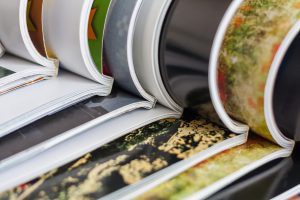
Now that so much media is electronic or digital, it’s hard to imagine there was ever a time before print media was invented. The earliest civilizations only had oral communication. If they had news to tell, they ran to the nearest person to spread the word to others, who each did the same until everyone had heard the news. Then people began to write down their news in picture form and then in crude languages where symbols stood for words and letters. It took the inventions of paper and the printing press for print media to come into regular use. Once it did, there was no turning back.
What Is Print Media?
Simply stated, print media is the printed version of telling the news, primarily through newspapers and magazines. Before the invention and widespread use of printing presses, printed materials had to be written by hand. It was a painstaking process that made mass distribution impossible.
At first, news was chiseled in stone. Later, it was handwritten and posted in a public area much like today’s posters or read from a scroll by a town crier. As early as 131 B.C., the ancient Roman government produced daily news sheets and informed the public in this way. Through the years, print media evolved to include entertainment, educational topics and more, instead of only conveying news.
A Brief History of Printing
Around the year 932, Chinese printers adapted wood blocks, which had been used to print illustrations and small amounts of text, and started producing popular books more easily. Each page of text was one block that could be used repeatedly to make the books.
About 100 years later, China’s Bi Sheng invented movable type by carving individual characters onto small blocks of clay. Each small block was hardened by fire to become a porcelain piece that could be used again and again. The pieces were glued to iron plates to make a page. Using each page hundreds or thousands of times, he could mass produce news quickly. When the printing was done, the pieces were removed from the plates to be used again to make other pages.
Bi Sheng’s invention had limited success in China because the Chinese alphabet’s characters are so large that they were difficult to put on movable type. His idea spread all over the world, however, and others adapted it using other materials such as wood, tin and copper. Still, the process was too cumbersome to mass produce a newspaper for the public.
Printing Press Mass Produces Newspapers
In 1440, Johannes Gutenberg introduced his invention of a movable type printing press with type that was much easier to change, making the mass production of news pages possible. The invention spread throughout Europe, and printing and distributing sheets of news became popular.
The World Association of Newspapers considers the first newspaper to be The Relation, which was published in Germany in 1604. It was published regularly (weekly), disseminated to the public and covered a range of news, from politics to entertainment.
The Oxford Gazette was the first English paper to be published, starting in 1665. It moved to London the next year and was renamed the London Gazette. It is still published today as the official publication of government news.
Although the early American colonies published news sheets, the first true newspaper was published in Boston in 1690. Called Publick Occurrences Both Foreign and Domestick, it ran into trouble for publishing political criticism. Its publisher, Benjamin Harris, was arrested and all copies were destroyed. While the American colonies were adamant about freedom of religion, freedom of the press was another matter.
The first successful newspaper in America was the Boston News-Letter in 1702. Its publisher, John Campbell, was careful not to publish any criticisms of the government. When Ben Franklin’s brother was arrested in 1722 for publishing news critical of the government, he turned over his paper, The New England Courant, to Ben.
This article comes from bizfluent edit released

